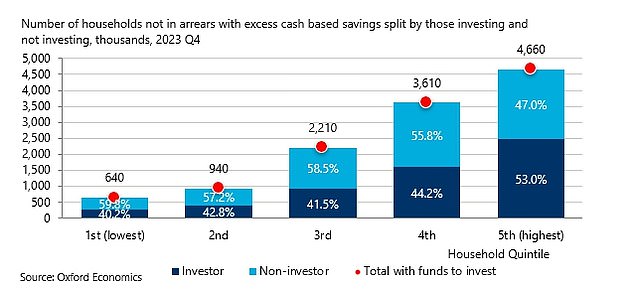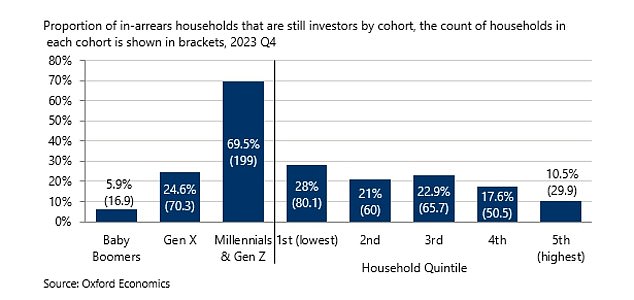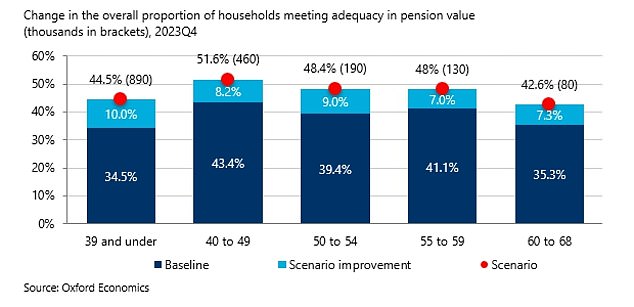The number of households with emergency savings has increased significantly in recent years – five financial trends emerged
More than 12 million Brits could improve their long-term financial situation by shifting money from cash or Isas to investments, a new report from Hargreaves Lansdown has found.
Many of us are not on track to have enough for a comfortable retirement, with only one in seven households putting enough into their pension pot for a comfortable retirement, according to the report exclusively provided to This is Money.
However, there are ways to turn this around by transferring money from existing savings or choosing an Isa to invest some of your savings rather than keeping the whole amount in cash.
We look at savings and investment trends and how Britons can close gaps in pensions and life insurance by moving savings.
More than twelve million Brits could improve their financial situation by shifting some money from cash to investments and pensions
1. More people have emergency savings than five years ago
The percentage of Brits who have no extra money at the end of each month has almost doubled between 2022 and 2023 – from 11 percent in 2022 to 21 percent in 2023, data from Nationwide Building Society shows.
But these new Hargreaves figures paint a different picture. This shows that the number of households with sufficient savings for emergencies has increased from 46 percent in 2019 to 63 percent now.
The jump over the past five years can be partly attributed to savings during lockdown, according to Sarah Coles, head of personal finance at Hargreaves Lansdown.
Coles said: ‘The increase in savings is largely due to lockdown savings, which many people are still clinging to – especially those on above-average incomes.
‘The financial turbulence of recent years has convinced people that they should hoard every penny and keep it on hand, just in case things get worse.
“It means they haven’t spent, and in many cases built on, their pandemic savings. However, the siege mentality has them clinging to them with cash on hand.”
Personal finance experts recommend putting three to six months’ worth of household expenses into a savings account.
The emergency fund should cover your rent or mortgage payments, utility bills, groceries, and child care and can be accessed immediately if your circumstances change.
2. Savers with large pots do not invest
The research shows that 12.1 million households have sufficient savings and are able to increase their assets for the future. But less than half of these are currently investing any extra money they have at the end of the month.
Households with an income over £77,400 are most likely to be investing their money, but still only around half of people in this group are currently investing.
There are 5.6 million households who have no payment arrears and have ample savings, but do not invest in a shares Isa.
This means that only 47 percent of the 12.1 million households without payment arrears and sufficient savings to invest comfortably actually take the step.
For these people, this is a missed opportunity, because investing in the long term allows your money to work harder.
If you put £20,000 into a savings account and paid 3 per cent over the next 20 years, it could be worth £36,415. If you put it into a stocks and shares Isa that earns 5 per cent a year, it could be worth £54,253 after 20 years – or almost £15,000 more, simply by moving your money around.
Moving extra savings that you know you won’t need in five to 10 years into stocks and shares Isas would improve long-term financial health, especially when it comes to later in life.

3. Those with less aside still invest
Younger and lower-income households are still managing to invest, even though they are in arrears and have less cash left over.
Figures show that 15.8 percent of households with payment arrears are currently investing.
Of these, nearly 70 percent of Millennial and Gen Z households in arrears are investing, compared to just 5.9 percent of Baby Boomers in arrears.
But this does mean that younger households may not have enough emergency funds for a rainy day, suggests Hargreaves Lansdown.
One of the reasons why Britons don’t invest extra money is familiarity with investments and financial education: households with better financial knowledge are more likely to invest than households with poor financial knowledge.
Coles says: ‘A large part of the reason why more people don’t invest comes down to the fact that they were never taught anything about investing, so unless they have specifically expressed an interest there is no reason why they would ever choose an investment fund. it up.
‘As a result, understanding of both investment and the impact of inflation is not very widespread.
‘It means that some savers will only focus on the interest they have paid on their savings, and not wonder how purchasing power has been eroded by inflation.
‘It means that some of them have lost money after inflation, and yet they feel like their money is growing because they see interest payments being added to it.
‘Others will never have thought about investments and therefore do not understand the growth potential.
‘We can see the impact that better understanding can have – because of those with better financial literacy, around half are investors – compared to less than a third of those with poor financial literacy.’

A greater share of younger and lower-income households in arrears are still investing compared to older households
4. We do not save efficiently for our pension
Only one in seven households, or more than 12.2 million people, has a pension large enough for a comfortable retirement.
Within this group of people, 6.9 million people could increase their pensions because they have excess savings and investments that can be channeled into their pension.
Helen Morrissey, head of pensions analysis at Hargreaves Lansdown, said: ‘Building a good retirement income can seem like a huge challenge, but for millions of households the key to helping themselves lies in their bank accounts and Isas.
By making small changes to the way they spend their money, they can make a huge difference to their retirement prospects.
Paying into a pension brings tax relief and because the money is invested rather than in cash, it has more opportunity to grow.
If you were to spend €400 per month in savings, with a growth of 3 percent, for twenty years, you would build up a savings pot of €131,321.
If you put it into a pension and the tax relief takes it to £500 a month, with 5 per cent growth, then after twenty years you might have £205,517 – giving you a lump sum that is £74,196 greater, without you have to pay for something extra.
If you are a taxpayer at a higher or additional rate, you will benefit even more as you benefit from a tax reduction of 40 percent and 45 percent respectively.
Morrissey said: ‘It’s a relatively simple behavioral change that could push 1.8 million households over the moderate retirement income threshold and secure their financial future, while significantly improving the prospects for the remaining households.’

Households with excess savings could spend this money on retirement, as only one in seven households is on track to have enough for a comfortable retirement
5. Gaps in life insurance can be closed
There are 14 million households with children in Britain, but more than half of them do not have enough life insurance cover to protect their families if something were to happen to them.
Those who own a home and/or have children require higher levels of life insurance coverage. Households with liabilities exceeding the value of their life insurance coverage have a life insurance gap.
The difference is £89,800 for those with children, but drops to £3,400 for the average renter without children. It’s an astonishing £194,200 for those who own a house and have children.
The report shows that there are 2.4 million households with no payment arrears and who can close their life insurance gap by using the savings they have left at the end of the month. But this is mainly because they are higher earners.
Sarah Coles says: ‘The good news is that 2.4 million households have a solution within reach, because they can afford to plug their life insurance gap with the extra money they have left at the end of the month – without going short come.
Some links in this article may be affiliate links. If you click on it, we may earn a small commission. That helps us fund This Is Money and keep it free to use. We do not write articles to promote products. We do not allow a commercial relationship to compromise our editorial independence.

